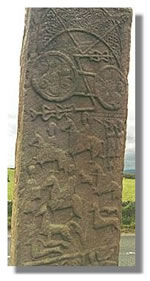
Using mathematical analysis, scholars at the University of Exeter have discovered that the symbols used in Pictish inscriptions are likely to represent a language, according to this article.
The team compared the Pictish symbols, which date from the 4th-9th centuries AD with more than hundreds of texts in known ancient and modern languages. They compared short and longer sequences of characters and concluded that the Pictish symbols seem to represent a language with a small vocabulary, however the meaning of the texts remains a mystery.
There are plans to apply these techniques to other undeciphered scripts such as the Indus Valley script.
I’m *still* trying to figure out whether that article was bona fide or intended as an April First Special…
I’ve seen so much stuff connected with language and writing systems recently that dangles over the precipice, barely hanging onto the top of the far edge of the Cliff of Reason by the nail of its left pinky finger (but Supremely, Unshakeably, Blissfully and Confidently unaware of its situation) that I don’t know quite *what* to make of this…
As far as I know, scientists know already that Pictish “wrote” a language, but the thing is it is still undeciphered.
Some even hypothesize that the initial changes in words, which is common in Celtic languages, is in fact a derived characteristic of the Pictish language. Yet, that is not proven of course.
The Indus valley script witnessed many people claiming deciphering it, but maybe the most famous one who spent more than 10 years (or 20 years maybe?) was a Finnish linguist. Does anyone know his name? I visited his own webpage once but I can’t remember his name.
TJ – Asko Parpola is the one you’re thinking of – here’s his website: http://www.harappa.com/script/
The frustrating thing about the original article linked to is that it doesn’t give the essential information you need to understand exactly what the researchers were working with and how they were interpreting their base data…
There is a counterpart to these “Pict”-ographs or the Indus Valley Script in the Philippines. In 1961 archeologists excavating a dig were sold a pot by treasure hunters (with the implication — but no proof — that it was associated with the excavation site). The special thing about the pot, now universally known as “the Calatagan Pot”, was that unlike any other piece of pottery yet uncovered in the Philippines, it has a string of characters inscribed around its “shoulder”, encircling the neck. It’s a curious mix of characters, many dead ringers for early variants of the Old Philippine (/Tagalog/Baybayin) script, others similar in form, and others that are jarringly rectilinear and angular, completely unlike the other curvilinear ones. And of the recognisable Baybayin letter shapes, many are written upside down so they are only recognisable when seen from above rather than from the side.
It is unclear when the object originated (an attempt at Accelerated Mass Spectroscopy analysis dated the inside to -2000 years and the outside to -6000), so there is no clear evidence that it dates to any time earlier than 1961. There have been several attempts at deciphering it, but none I have yet seen really measures up. The earliest took the easy route: an expert in Philippine antiquities had the obvious idea of contacting the pot’s maker in a seance and asking him what the inscription said. (So there!) Others have tried guessing at possible values of the various characters but with no great success. (To my endless bafflement, although nearly everyone recognises an upside-down ‹m› character, not one of the accounts I have seen has yet taken the next logical step to recognise that there are several other Baybayin shapes inscribed upside down…!)
One of the most recent attempts I have seen used statistical analysis as part of its toolbox in order to attempt a decipherment, but still missed some important features of the characters themselves. That’s what this latest attempt at deciphering these pictographs reminded me of.
BTW no plausible attempt at deciphering the Calatagan Pot Inscription has yet been published in any place with peer review, as far as I know. My take? Either an authentic inscription whose author attempted to encode a message by playing around with how the characters were written, or a mid 20th century hoax by someone making use of a “ransom note” mix of characters from various indigenous Philippine script varieties available in a grab bag of published sources by the mid-1900s.
Yes!
he’s the one 🙂
Don’t you think he cracked it already?
http://languagelog.ldc.upenn.edu/nll/?p=2227